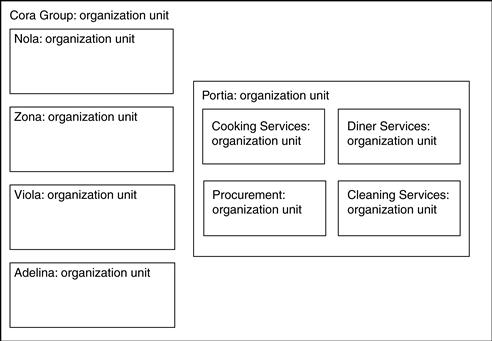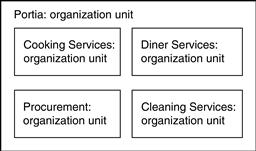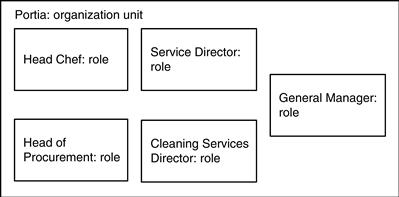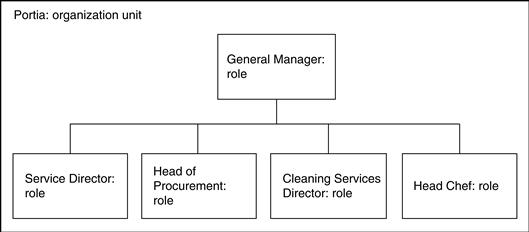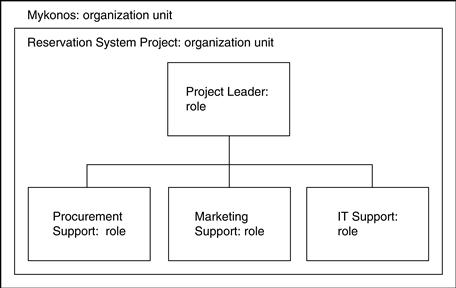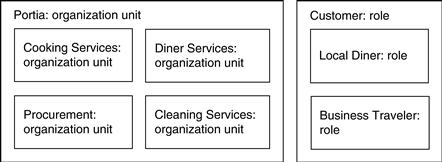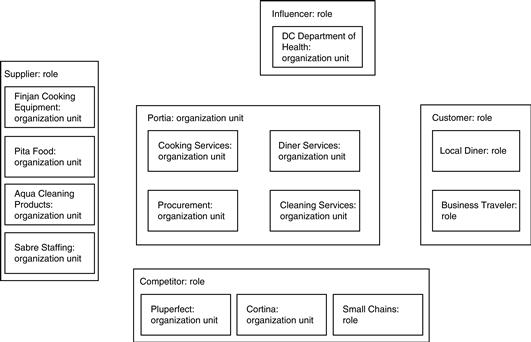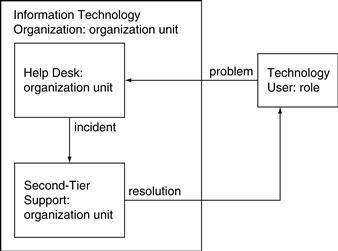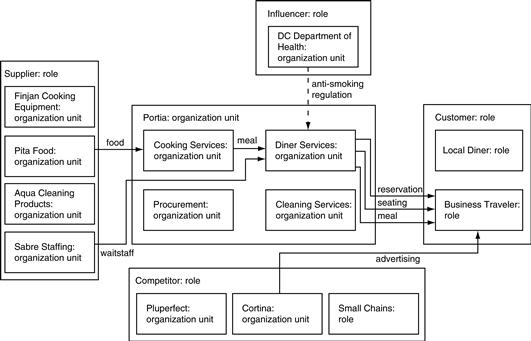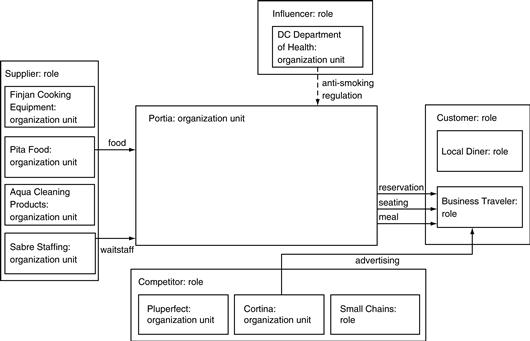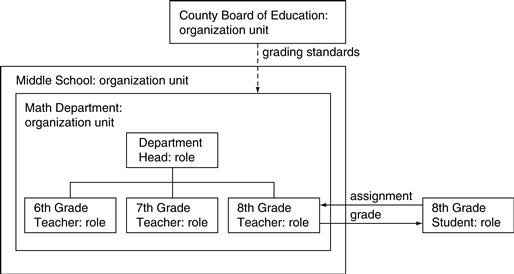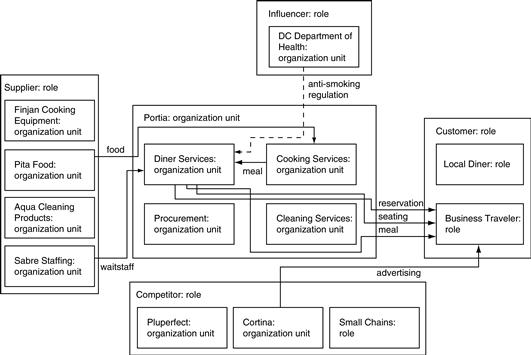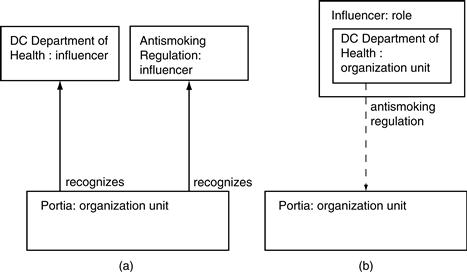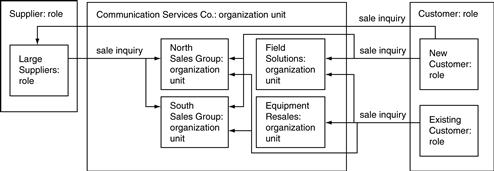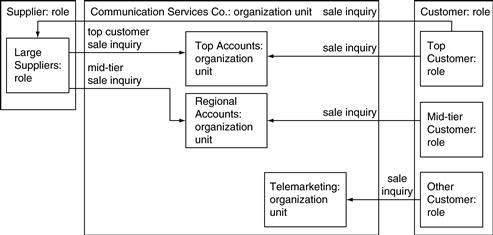Business Organization Models
Business organization modeling is the second of the four business modeling disciplines we describe in this book. A business organization model describes how a company is organized—the business units and departments and working groups within it. A business organization model describes the interactions—who interacts with whom to get the work done. A business organization model describes the roles that people play in the company. It also describes the way a company interacts with other organizations outside the company. This chapter explains business organization models.
Now that the decision has been made to acquire Cora Group, it must be integrated into the far larger Mykonos Corporation. Mykonos has acquired many restaurants, but most have been acquired individually. Acquiring an individual restaurant is straightforward. After the acquisition, the general manager of the acquired restaurant reports to the appropriate regional head of restaurants. Purchasing responsibility for bulk food and kitchen equipment is transitioned to Mykonos Purchasing, to take advantage of existing vendor relationships and bulk purchasing agreements. Responsibility for human resources and employee benefits is transitioned to Mykonos HR, always a welcome change for the acquired restaurant.
The acquisition of Cora Group is different. Cora Group is a company of several restaurants, with a small central office that already performs some of the functions to be transitioned to Mykonos Corporate. You expect that both purchasing and human resources could be supplied by Mykonos more cheaply and better than Cora Group performs those functions today. But before you make any changes, you plan to better understand the Cora Group.
You start by exploring the way Cora Group and its individual restaurants are organized. You want to understand who dines at the restaurants and who the competitors are. You need to learn whether Cora Group uses the same vendors as Mykonos so that you can determine whether purchases can simply be consolidated or whether vendor changes will need to be made. By understanding how the individual restaurants function, you can weigh the difficulty of transitioning responsibilities to Mykonos.
To achieve this understanding, you create a business organization model. A business organization model shows the organizations inside a company, how they interact with each other, and how they interact with other companies.
Business organization models include organizations—collections of people who work toward a common goal. Some organizations in a business organization model are inside the company.1 An organization model for Cora Group includes the restaurant Portia as well as the other restaurants that are part of Cora Group. Other organizations in a business organization model are outside the company. An organization model for Cora Group includes Sabre Staffing, a company Cora uses to hire waitstaff.
Organization models include roles—what people do within an organization. An organization model for Portia includes the role of chef. Each of the people who prepare food at Portia plays the role of chef.
Organization models include associations—ways that organizations and roles relate to each other. For example, one type of association in the organizational model of Portia is the reporting relationship between a chef and the Portia general manager.
Why Model Business organizations?
To better understand why we want to create business organization models, let’s consider the eight purposes of business modeling, first identified in Chapter 1. Of these eight, business organization models can achieve four purposes: communication, training and learning, persuasion and selling, and analysis.
When you return from your exploratory visit to Cora Group and report to Mykonos management, the organization models help you communicate what the Cora Group organization does and how it does it. Organization models are also useful to communicate changes. After a corporate reorganization you use an organization model to show the changes in structure and reporting. You also show how interactions have changed between groups within the company and with business partners outside the company.
Companies perform projects. When performing a project, organization models help communicate the project scope. Some of the organizations in an organization model are in scope for the project and some are out of scope. We use organization models to achieve consensus among project stakeholders about what is in and what is out. By including some organizations, some roles, and some associations in the model and leaving others out, we reach agreement about what to attempt in the project.
Sometimes business organization models are used to train and learn. New employees can learn about the other people they must interact with. New employees can learn the roles they must play and their place in the organization.
An organization model can be used to represent a past state of a company, the current state, or a future state. The models of different periods can be compared to each other and analyzed. We study a company after a proposed reorganization to understand the impact on the customers. We determine whether the proposed reorganization will simplify the interactions with customers, or make them more complex.
These same organization models are used to persuade senior management which alternative reorganization should be performed. Employees can be persuaded of the benefits of a planned reorganization. They can see where they will be located in the new organization, and they can see how their responsibilities and interactions will change. Some responsibilities and interactions will change and some will not.
Organizations
An organization unit (or more simply stated, an organization) is a collection of people who work together toward a common goal. An organization has a clear boundary. Some people are part of Portia and others are not. An organization usually has structures within it. Mykonos has Mykonos Purchasing, Mykonos Finance, Mykonos Atlanta—for the restaurants in the Atlanta metropolitan area—and so on. An organization can be part of another organization. For example, before the acquisition, Portia was part of Cora Group.
A corporate holding company provides another good example of organizations that are part of other organizations. Within a holding company, each company has its own management structure, its own performance goals, and its own budgets and resources. But all the companies within the holding company are connected. Their performance flows up to the holding company, and their goals are part of a larger plan.
An organization can be a commercial company, a nonprofit, or a government agency. An organization can be a smaller group of people within a larger organization. An organization can even be temporary. A temporary project team is an organization. The team exists while the project is performed and then disappears after the project is finished.
When we model organizations, we look at the way they are structured, the work they perform, and the way they are associated with other organizations. We do not focus on how they perform their work. How they perform their work is instead modeled as business processes and is described in Chapter 5.
As part of your exploration of Cora Group, you create some organization models. Figure 4.1 shows Cora Group and the five restaurants that are part of it: Nola, Zona, Portia, Adelina, and Viola. Cora Group is an organization unit. Each of the five restaurants is also an organization unit. Each restaurant is shown graphically as being enclosed by Cora Group. This graphical enclosure means that there is a part of association between the two: Nola is part of Cora Group, as are each of the other four restaurants.
Business organization models are different from organization charts. Compare Figure 4.1 to the organizational chart we first saw in Chapter 2, which is shown again as Figure 4.2. There are two differences. First, the business organization model (in Figure 4.1) shows us the organizations that comprise Cora Group instead of people and their roles. Instead of seeing Dan Hamscher, the general manager of Nola, we see Nola. Second, the organization model shows what organization is part of what other organization rather than the reporting relationships between people. Instead of seeing that Dan Hamscher reports to Sam Coates, we see that that Nola is part of Cora Group.
We use the part of association to show the organizations that are part of a larger organization. In Figure 4.1, Cora Group is composed of five restaurants, each of which is part of Cora Group. Figure 4.1 shows no association between Adelina and Viola and in fact no associations between any of the restaurants within Cora Group.
The size of the rectangle that depicts an organizational unit in an organization model is not significant. In Figure 4.1 Cora Group is shown larger than Nola not because it is a bigger organization (although it is) but because we want to show Nola as enclosed within Cora Group to depict the part of association between them. The size of the organizational unit in an organization model means nothing.
The location of an organizational unit within an organization model diagram also means nothing. In Figure 4.1, Nola is located above Zona, but that does not mean that Nola is more important or larger than Zona or anything at all. Location implies meaning in an organization model only when one organization encloses another. All other location matters are purely aesthetics.
Each organization has a name and a description. The description of the organization includes several sentences detailing the purpose of the organization, a bit of its history, and the functions it performs. For example, the description for Adelina is:
Adelina is the critic’s favorite restaurant of the Cora Group. It is located in Washington, DC. Adelina opened in 1997 and specializes in authentic Greek seafood dishes. Adelina has earned a Zagat food rating of 24 and has been ranked as one of Washingtonian Magazine’s “100 very best restaurants” for eight years in a row.
Business organization models are inherently hierarchical. An organization is composed of several other organizations, which are in turn composed of other organizations. Figure 4.3 shows Cora Group as composed of five restaurants. One of those five—Portia—has four more organizations that are part of it: Diner Services, Procurement, Cooking Services, and Cleaning Services. Diner Services is responsible for all interactions with the customers of Portia: hosting, reservations, and serving food. Procurement is responsible for all interactions with external vendors and suppliers. Cooking Services is responsible for the creation of all meals. Cleaning Services is responsible for cleaning the facilities, including the dining area, bathrooms, and immediate restaurant surroundings.
Of course, there are limits to showing the inherent hierarchy of organizations in a single diagram. Figure 4.3 is a three-level diagram showing Cooking Services as a part of Portia, and Portia as part of Cora Group. Three levels is about the limit of a single diagram. If we added a fourth level—Cora Group as part of Mykonos—the diagram would be harder to understand. Cooking Services becomes too small to read. Five levels is even worse.
An alternative to Figure 4.3 is to show the organizations within Portia as a separate diagram. Figure 4.4 illustrates this approach. The advantage of a two-level diagram like Figure 4.4 is that it is simpler, and easier to understand.
Roles
A role is the responsibility a person assumes when he or she holds a position in an organization. When a person assumes a role, she is bound by the expected social behavior that accompanies that role. For example, consider the role Host. We expect the host to take reservations, greet diners, and assign the diners to tables. We also expect the host to be pleasant and patient when interacting with the diners, since this role is the initial contact the restaurant makes with diners. The host represents the restaurant to the dining public.
Organizations contain roles. In a business organization model we show the roles contained within an organization using the same enclosing part of association that we saw earlier. Just as an organization can be part of another organization, a role can also be part of an organization. Figure 4.5 shows five roles that are part of Portia: Head Chef, Service Director, Head of Procurement, Director of Cleaning Services, and General Manager.
Note the similarity between Figure 4.5 and Figure 4.4. The Head Chef role in Figure 4.5 leads the Cooking Services organization in Figure 4.4. Similarly, Service Director in Figure 4.5 leads the Diner Services organization in Figure 4.4, Head of Procurement in Figure 4.5 leads Procurement in Figure 4.4, and Cleaning Services Director leads Cleaning Services. Figure 4.5 has a fifth role, General Manager. In fact the General Manager does not lead one of the organizations within Portia; he leads the whole of Portia.
As with organizations, the placement of roles is not significant when using the enclosing part of association. In Figure 4.5, it does not matter whether Head Chef is to the left of Service Director or to the right of it. Both Head Chef and Service Director are part of Portia.
Figure 4.5 is not so useful because it does not say very much. It only says that Adelina has five roles: Head Chef, Service Director, and so on. It can be made more useful by adding the reporting relationships that exist between the roles [Harmon 2003], as shown in Figure 4.6. The role Service Director reports to the role General Manager, as does Head of Procurement, Cleaning Services Director, and Head Chef.
What does it mean for one role to report to another? The supervising role—the role reported to—has some authority over the reporting role—the role that reports. The supervising role can tell the reporting role what to do and when to do it. The reporting role is responsible for informing the supervising role about progress made and issues encountered. The supervising role is ultimately responsible for the actions and work of the reporting role. Everything done on his behalf is his responsibility, even if done poorly by the reporting role.
In depicting reporting relationships, business organization models use the same diagrammatic conventions as do organization charts. The reporting association itself is shown as a line without arrowheads. No arrowheads are needed because the direction of the reporting association is implied by the physical layout. The reporting role is lower in the diagram than the supervising role. In Figure 4.6, Service Director reports to General Manager (rather than vice versa) because Service Director is closer to the bottom of the diagram and General Manager is closer to the top. The line itself is from the top of the reporting role and to the bottom of the supervising role, from the top of Service Director to the bottom of General Manager.
Reporting only occurs between two roles. A role cannot report to an organization, nor can an organization report to another organization.
Role reporting and organizational composition can be combined. Figure 4.7 shows an example: the reporting structure of a project to deploy a new restaurant reservation system. The project has a project leader and three roles reporting to that leader. All four roles are part of the Reservation System Project, and that organization is part of Mykonos.
The people who play the roles on this project also play other roles in the organization. For example, the person who plays the Marketing Support role—Janice Buckler—has a primary role as Marketing Manager reporting to Marketing Director. Both Marketing Manager and Marketing Director are part of Mykonos Marketing. (Neither role nor the organization are shown in Figure 4.7.) For her Marketing Support role, Janice is responsible for ensuring that the reservation system is implemented in a way that does not hurt the image of the Mykonos restaurants.
Business organization models that only show an organizational chart reporting structure are not very interesting on their own. We can learn a bit about the way the organization is structured and who reports to whom. But we cannot tell who procurement interacts with and which vendors supply the restaurant. We cannot tell who at Portia interacts with the customers. We cannot tell anything about the customers they service, such as whether they are local diners or business travelers. And we cannot tell who Portia’s competitors are.
Most organization charts look alike. They have CEOs or presidents at the top; they have departments such as finance and sales and human resources. It is difficult to understand the differences between organizations simply by looking at the reporting relationships.
External Organizations and External Roles
The organizations and roles we have investigated so far are inside Mykonos. The organization chart, the organizations within Portia, and Portia’s place within Cora Group are all part of the larger Mykonos Corporation. Everything is ultimately part of the same organization.
But of course, Portia interacts with other organizations and roles that are outside Mykonos. Portia serves restaurant customers, acquires supplies from vendors, and competes with other restaurants. Customers, vendors, and competitors are not part of Mykonos. They are external.
A business organization model can show how Portia interacts with external organizations and external roles. External organizations and external roles are shown outside the Portia organization unit. For example, Figure 4.8 shows the role Customer. Customer is not contained within Portia; it is an external role.
In Figure 4.8, Customer is shown to the right of Portia. In business organization models, the convention is to show customers on the right. But customers of whom, and to the right of what? Customer is a customer of Portia. Portia is the organization of interest in Figure 4.8; it is the organization we are focusing on, the reason the model exists. In Figure 4.4, the organization of interest is also Portia, but there are no external roles, so the organization of interest encompasses the whole diagram. In Figure 4.8, there is a role, Customer, external to the organization of interest.
The role Local Diner in Figure 4.8 is shown as part of the role Customer. This is a new kind of association. We have seen roles that are part of organizations, and organizations that are part of other organizations, but we have not yet seen roles that are part of roles. When a role is part of another role, the enclosed role—the one inside—plays the part of the enclosing role—the one outside. Local Diner plays the part of Customer to the organization of interest, Portia. Business Traveler also plays the part of Customer.
Portia interacts with other external roles. Portia has suppliers—companies that provide kitchen equipment and fresh meats and vegetables. Portia has competitors—other restaurants that compete for the same clientele. Some organizations influence Portia; these influencers pass rules or policies that impact the operations of the restaurant. Figure 4.9 shows four roles external to Portia: Supplier, Competitor, Influencer, and Customer. By convention, the Supplier role is shown to the left of the organization of interest, the Competitor role is shown below it, and the Influencer role is shown above it.
Cortina is a restaurant around the corner from Portia and a clear competitor for Portia’s business. In Figure 4.9 the organization Cortina is shown as part of the role Competitor. When an organization is represented as part of a role, it means that the organization plays that role with respect to the organization of interest. The restaurant Cortina plays the role of a competitor to Portia. The organization Pluperfect is also part of the Competitor role because it is another restaurant competing with Portia.
The Competitor role has a third model element within it. The role Small Chains is part of Competitor. Small Chains represents mid priced restaurants that do not offer the same atmosphere and dining experience as Portia but compete with it for some customers.
In the Supplier role to the left are four organizations that supply products and services to Portia. Finjan Cooking Equipment provides cooking equipment: ovens, steamers, pots and pans, and knives of all varieties. Pita Foods provides food supplies. (Of course, there are many other food vendors not shown in Figure 4.9.) Aqua Cleaning Products provides cleaning services. Sabre Staffing provides waitstaff and other talent for hire.
The Influencer role is by convention shown above the organization of interest. Influencers are organizations that affect Portia. In Figure 4.9, DC Department of Health is an influencer; it recently banned smoking in public places, including bars and restaurants. This ban is significant, and Portia personnel must enforce it. The General Manager of Portia is concerned about the effect on diners who like to smoke. Will they go elsewhere, perhaps across the river to other restaurants in Virginia that allow smoking? Should Portia build an outdoor patio for smokers?
The appropriate detail for a business organization model depends on the way the model is to be used. Each situation is different. Sometimes just a Customer role is sufficient, without showing specific customer organizations or roles. At other times more detail is needed within Customer. For example, in Figure 4.9 we show two customer roles, Local Diner and Business Traveler. We segment customers into two roles so Mykonos Marketing can explore how competitors interact with different customer segments.
Interactions
We have seen how an organization can be part of another organization and how the part of association works with roles as well: A role can be part of an organization, an organization can be part of a role, and a role can be part of another role. We have also examined the reporting association: how one role can report to another. Now let’s look at interactions, a third kind of association between model elements in a business organization model.
An interaction shows who works with whom. Two organizations participate in an interaction if they work together, at least sometimes. When two organizations work together, usually something is passed from one organization to the other, some good or service delivered. This deliverable can be something final, like a restaurant meal, or it can be some work in progress, like a drink order. It can even be something purely conceptual, like an idea for a new menu item.
Roles can also participate in interactions. A role can interact with another role, and a role can interact with an organization.
Let’s consider an example. Figure 4.10 shows a technology user calling a help desk about a problem concerning a software application. The help desk performs initial diagnosis on the problem and may refer it as an incident to second-tier support. Second-tier support supplies a resolution back to the user.
There is an interaction between the role Technology User and the organization Help Desk. The interaction is shown as a solid line with an arrow. The interaction is labeled with the deliverable: problem. The interaction is directional, from Technology User to Help Desk. This means that the technology user delivers the problem to the help desk, rather than vice versa.
Figure 4.10 shows an interaction between Help Desk and Second-Tier Support. The help desk organization provides second-tier support with an incident, a written description of the problem recorded and tracked. Figure 4.10 shows the resolution of the problem as a third interaction, one between Second- Tier Support and Technology User. That interaction delivers a resolution to the user.
Because Second-Tier Support is part of the larger Information Technology Organization, there is an implied interaction between Information Technology Organization and Technology User. This interaction is not explicitly shown in Figure 4.10 but is implied by the presence of an existing interaction, the one labeled with the resolution deliverable. This implied interaction also delivers a resolution. Similarly there is another implied interaction between Information Technology Organization and Technology User to deliver the original problem.
Note that time is not shown in Figure 4.10. Of course there is a temporal order to the interactions in this example. The technology user shares the problem with the help desk before the help desk escalates it as an incident to second-tier support and before the problem can be resolved. But Figure 4.10 does not show that temporal order. Instead, Figure 4.10 just shows that the technology user works together with the help desk and that as a result, a problem is delivered. From what’s shown in Figure 4.10 the problem interaction might happen before, after, or concurrently with the resolution interaction.
The interaction between a role and an organization (or between two organizations or two roles) is labeled with the name of a deliverable, and the direction of the arrow indicates who provides the deliverable and who receives it. But often more than one deliverable is provided, and sometimes deliverables travel in both directions. For example, in the interaction between Technology User and Help Desk in Figure 4.10, the help desk sometimes provides a resolution for simple problems directly to the user, without involving second-tier support. This second deliverable from Help Desk to Technology User is not shown in Figure 4.10. It is better to show a single interaction between the two model elements that interact and to label that interaction with the most important deliverable. Between these two model elements, the most important deliverable is the problem that the user provides to the help desk.
Interaction deliverables can take several alternative forms. Information can be a deliverable. For example, Portia provides total sales to Mykonos Finance every day. A request can be a deliverable. For example, when the Portia general manager is preparing schedules for waitstaff, Portia server will request the days she wants to work. A physical good can be a deliverable. For example, the Portia vendor Pita Foods provides fresh basil and lemon grass every day to Portia. And a service can be a deliverable: Aqua Cleaning does a thorough cleaning of Portia every night after closing.
Figure 4.11 shows several interactions. Local Diner interacts with Diner Services in three distinct interactions. One interaction results in a diner receiving a reservation, the second results in seating, and the third in a meal. The Business Traveler role also interacts with Diner Services via the same three interactions. Both roles—Local Diner and Business Traveler—receive a reservation, seating, and a meal.
Some interactions are between Portia and its customers. Other interactions are internal to Portia, between Portia organizations. In Figure 4.11, Cooking Services and Diner Services interact. The interaction shows a meal as a deliverable from Cooking Services to Diner Services. The meal is prepared by a Cooking Services chef and then served to a diner by a Diner Services server.
Figure 4.12 has the same roles and organizations as Figure 4.9 but with interactions between several model elements. Figure 4.12 shows a single scenario: a business traveler enjoying a restaurant meal at Portia. In addition to the interactions we have already seen—those between Business Traveler and Diner Services—there are some new interactions in Figure 4.12. Pita Foods interacts with Cooking Services, providing food such as olive oil and semolina flour. Sabre Staffing provides waitstaff to Diner Services.
Only the interactions that are part of this business traveller scenario are shown. Although Cleaning Services certainly interacts with the cleaning vendor Aqua Cleaning, there is no interaction shown in Figure 4.12 because that interaction is not part of the scenario.
Note that there is no interaction between Business Traveler and Pita Foods. The lack of an interaction association reflects the fact that business travelers simply do not deal directly with this restaurant vendor. In other business organization models customers do interact directly with vendors. For example, when buying a sweater from a catalog, a customer will receive the sweater from the shipper, a vendor of the catalog retailer.
Business travelers also interact with Cortina, a competitor of Portia. Cortina has placed advertisements in the hotel magazines to attract business diners to its restaurant. That interaction between Cortina and Business Travelers is shown in Figure 4.12, labeled with the deliverable advertising.
Interaction Best Practices
As mentioned earlier, an interaction is labeled with a deliverable, a good or service provided from one interacting organization to the other. The direction of the arrow indicates who provides the deliverable to whom. Usually this direction is clear, as when Diner Services provides a meal to Business Traveler.
But sometimes it is not so clear which way the arrow should point. Occasionally, both parties in an interaction deliver the same good or service. For example, when the New York Yankees baseball team trades players with the Baltimore Orioles, should the interaction be from the Yankees to the Orioles, or vice versa? For these equal trades of the same kind of thing (e.g., two professional ballplayers), a bidirectional interaction—one with an arrowhead at each end—is appropriate.
Bidirectional interactions are not so common. For the vast majority of commercial transactions, a good is not traded for another good, but sold for money. In this typical situation, the purchased good is shown as an arrow, and the money is not shown at all. Instead it is implied. Money flows upstream, against the direction of the arrows.
When two organizations interact, often a variety of goods and services is provided from one to the other. We have seen business organization models created by novice modelers with six or seven interactions between a single pair of organizations. But too many interactions on a single diagram make it difficult to understand, and obscure the key meaning of who is interacting with whom. Best practice is to limit the deliverable to the single most important one in the interaction.
Some novice modelers mistakenly use interactions to show activities performed by an organization rather than interactions and deliverables. An organization model should show the interaction deliverable meal, not the steps of the process to create the meal. Steps such as ordering, serving drinks, serving appetizers, and so on are captured in a business process, as described in Chapter 5.
Influence
When two organizations work together, we represent that working together with an interaction between them. But an organization can have an influence on another organization, even when they don’t work together. This is a different kind of association between the two organizations, not an interaction but an influence.
Figure 4.12 includes an example of influence: the dashed line from DC Department of Health to Diner Services. The organization DC Department of Health enforces a ban on smoking, influencing Diner Services and indirectly affecting the diner. The health department is not working together with Diner Services. Instead its antismoking regulation has influenced the behavior of Diner Services. Because of this influence, Diner Services must now remind people not to smoke and must seat smokers at the bar instead of in the restaurant proper.
One organization can influence another organization, as in Figure 4.12. One role can influence another role. And an organization can influence a role, or vice versa.
Influence is similar to interaction. Both associations are between two organizations (or two roles or one of each). But influence is indirect. The organizations do not work together, as they do if they interact. Instead one indirectly affects the behavior of the other.
White Boxes and Black Boxes
In Figure 4.12, Portia is said to be modeled as a white box, revealing details about how it is organized internally. We can see the organizations that are part of Portia, the interactions between those internal organizations, and the interactions between the internal organizations and those outside Portia. Much detail is revealed.
Alternatively, Portia can be modeled as a black box, hiding internal details. Figure 4.13 shows a black-box model of Portia. No detail is shown within Portia, no organizations or interactions inside. Interactions and influences are to Portia itself rather than to an organization within. For example, in Figure 4.12 Pita Foods interacts with Cooking Services, supplying the deliverable food. In Figure 4.13, the same interaction is between Pita Foods and Portia instead of Pita Foods and Cooking Services.
Black-box models are created when the internal details about an organization are not available. The viewer simply doesn’t know how Portia is organized. But more often, black-box models are created when the internal details are not important. Modeling is always a tradeoff between detail and simplicity, and sometimes simple is better. Black-box models are sometimes better than white-box models.
Note that most business organization models have black boxes—organizations that are not detailed. For example, Pita Foods, Cortina, and DC Department of Health are all shown as black boxes in both Figure 4.12 and Figure 4.13. All three organizations have internal detail, but we do not show it. Similarly, in Figure 4.12 there are four organizations within Portia. All four are shown as black boxes.
Associations
As we have seen, organizations (and roles) can be associated in four different ways: part of, reports to, interacts with, and influences. Figure 4.14 shows an example of each of the four associations in the same model. The situation shown in Figure 4.14 represents a middle school student interacting with a teacher, turning in assignments and receiving grades.
As you will recall, one organization can be part of another, larger organization. The part of association is depicted by showing the smaller organization contained within the larger. In Figure 4.14 the organization Math Department is part of the organization Middle School. The roles Department Head and the three teacher roles are part of the organization Math Department. The role 8th Grade Student is not part of the organization Middle School, nor is the organization County Board of Education.
One role can report to another via the reports to association. In Figure 4.14 the role 6th Grade Teacher reports to the role Department Head, as do the other two teachers.
One role can interact with another, and roles can interact with organizations. In Figure 4.14, the 8th Grade Student interacts with the 8th Grade Teacher. The deliverable assignment is provided from the student to the teacher and the deliverable grade is provided from the teacher to the student.
One organization can influence another. Figure 4.14 shows the organization County Board of Education influencing the Math Department. The Board of Education creates grading standards for all the math teachers, influencing the behavior of the department without interacting with it directly.
Creating Good Business Organization Models
Novice modelers often create business organization models that are too big and too complex to understand. Too many model elements—or too many associations between those model elements—renders an organization model useless. When too many associations are shown in one organization model it is difficult to make sense of the whole. To improve readability and simplify the model, it is better to create several separate model diagrams, each with some of the detail but none with all of the detail. Each model can show a single scenario and just the few model elements and associations involved in that scenario. This strategy of selective revelation—described further in Chapter 7—is handy for creating models in any of the four business modeling disciplines, but it is particularly useful for business organization models. We often create organization models that reveal only the parts used in a particular scenario and omit the parts that clutter the model and that are irrelevant to that scenario.
Let’s consider a Portia example of selective revelation. We create one model that shows the interactions between a customer and Portia. We include Diner Services, Business Traveler, Cooking Services, and the interaction among them. A second model shows the interactions between Portia and the suppliers. A third model shows how the organizations within Portia interact over a longer period of time with other restaurants and with organizations at Mykonos headquarters. Each of these models is understandable on its own. Together they describe how Portia interacts with other organizations.
Creating scenario-based organization models is easy. Each model includes only the organizations and interactions involved in a single scenario. An existing complex model can be changed into several different models, each model showing only the organizations and associations for a single scenario.
Selective revelation is usually performed by scenario for organization models—with different models showing different scenarios—but it can instead be performed by the part of hierarchy. We saw this arrangement using part of earlier in this chapter. Figure 4.3 showed organizations that are part of Cora Group, including Portia, and Figure 4.4 showed the organizations that are part of Portia. We could have combined Figures 4.3 and 4.4 in a single diagram, but the result would have been too big and would have contained too much information. Selectively revealing organizations is better.
Similarly, selective revelation can be applied to the reporting hierarchy. Rather than showing 30 roles and their reporting relationship on the same diagram, it is better to show the roles in several separate diagrams.
The physical positioning of model elements is also important to make a model readable. If an interaction is shown between two organizations, the interacting organizations should be close to each other so that the interaction is drawn as a short line instead of a long one. Figure 4.15 shows an example of what happens when interacting organizations are far from each other. Figure 4.15 is the same model as Figure 4.12 but with the positions of Diner Services and Cooking Services swapped. Figure 4.15 has interactions from suppliers to Cooking Services and from customers to Diner Services. The interactions cross, making it harder to figure out which organizations interact. Figure 4.15 is harder to read than the equivalent Figure 4.12.
Some modeling tools help with readability. Some tools provide different icons to support the visual distinction between organizations and roles. Other tools support the user selection of an organization and the subsequent drill-down to the organizations that are part of the selected organization. Each organization shows only the model elements with which it is associated. Other model elements are revealed on the drill-down, when the sub–organizations are shown.
Organizations and Business Motivations
In this chapter we explain organization models, showing how organizations can be associated with roles. But we have already seen organizations in Chapter 3 as part of business motivation models. We saw that an organizational unit can define a goal or an objective, can establish a strategy or a tactic, can recognize an influencer, and can make an assessment that an influencer is an opportunity or a threat. The organizations in Chapter 3 that do all this defining, establishing, recognizing, and assessing are the same as the organizations described in this chapter.
Figure 4.16 shows two perspectives on influence, one using a motivation model and the other using an organization model. In a business motivation model, an organization unit can recognize an influencer. As you will recall, an influencer is a market trend, a law, another organization, or something else that influences the success of the organization. An organization recognizes influencers using the recognizes association. In Figure 4.16 (a) the influencer Antismoking Regulation is recognized by Portia as an influencer. DC Department of Health is also recognized as an influencer, as an entity whose actions influence Portia.
Figure 4.16 (b) is a business organization model. Instead of showing the recognition of DC Department of Health as an influencer, Figure 4.16 (b) shows the influence itself. DC Department of Health influences Portia via the regulation of smoking. The regulation is a deliverable of the influence association, and the influencing organization—DC Department of Health—is the source of the influence association.
The traceability between an organization model and a motivation model can be used to better analyze the models. We can compare the goals of a smaller organization with the goals of the larger organization it is part of. Are there missing goals—goals that will not be achieved because no one is addressing them? Are goals in conflict? Similarly, we can compare the strategies of the smaller organization with those of the larger.
Standards
Today no standards exist for organization modeling. Every modeling tool has its own approach to this problem, and every business that performs business modeling does the modeling in its own way. Much variety exists.
The relationship map developed by Rummler and Brache [Rummler and Brache 1995] is perhaps the closest to a standard, albeit a de facto standard with as many variants as practitioners. Rummler and Brache describe a systems view of organizations in which organizations and their components are depicted with rectangles nested within other rectangles. Customers, suppliers, and other external organizations (or roles) are shown by rectangles outside the main organization. Interactions labeled with deliverables connect the organizations (or roles) to show how work gets done, both within and across the organizational boundaries.
Rummler and Brache also introduce the concept of including an organization chart—with reporting associations—within the relationship map view of the organization, much as we have shown earlier in this chapter. Paul Harmon further elaborates on this idea and shows how a chart with the reporting structure of functional units is embedded within the organization model [Harmon 2003].
The organization models presented in this chapter are broadly consistent with the work of Rummler and Brache and with Harmon’s extensions. Many commercial modeling tools have also built on the work of these thought leaders, so our presentation is also broadly consistent with commercial modeling tools.
The Object Management Group has started to create a standard for modeling organizations. Currently the OMG organizational modeling work is paused, waiting until more companies (and government agencies) show interest in this standardization. As of early 2008, we believe the OMG is several years away from a standard that will address the modeling of business organization models.
Without standards, modelers will continue to rely on a combination of ad hoc approaches and the proprietary modeling languages built into the modeling tools they use today. Each modeling tool and ad hoc approach is different. Sometimes the differences are obvious. Worse, sometimes the differences are subtle. The model elements and associations that look the same in two tools have subtle differences in meaning. These differences create two problems. Analysts looking at diagrams created in different tools cannot accurately (or easily) interpret and compare the models. And models cannot be exchanged between different tools.
Case Study
A telecommunications services company saw some significant profitability differences between various business units. Some business units were more profitable than others, even for the same services. Why? Were the more profitable business units simply better organized? Should the less profitable business units be reorganized to resemble the more profitable ones? Were either the more profitable or the less profitable business units following industry best practices?
Each business unit had its own sales organizations and its own customer service organization. The North Sales Group and the South Sales Group handled regional sales, one for northern customers and the other for southern customers. The Field Solutions Group handled solutions for new customers and existing customers, and the Equipment Resales Group provided used telecommunications equipment to existing customers. The company also had other corporate departments: Marketing, Finance, Legal, Procurement, and Operations.
To help the company explore organizational alternatives, we created business models. We created business motivation models to capture the goals, problems, and opportunities. We created business process models.
We also created several organization models. We created both an organization model of the existing situation and organization models for each of several alternative scenarios. The model of the existing situation captured the interactions between the current business units and the customers, influencers, and suppliers. The customer interactions included billing and collections, service delivery, inbound sales requests, contract approval, orders, support and maintenance, inquiries, prospecting, and customer qualification. Figure 4.17 shows one of the model diagrams for customer sales inquiries.
The telecommunications services company considered two customer segments: new customers and existing customers. When a new customer made a sales inquiry, they could contact one of three different internal organizations: Field Solutions, North Sales Group, or South Sales Group.
Or a new customer could contact a large supplier directly, resulting in an indirect sales inquiry to one of the regional sales groups. Similarly, an existing customer could contact one of four different internal organizations: Field Solutions, Equipment Resales, North Sales Group, or South Sales Group. The multiple interaction points made it difficult to understand the customer relationship. Customer information was kept in multiple databases, further impeding a single view of a customer.
Customers who recognized the multiple entry points exploited the duplication by arranging for the organizations to bid against each other. A customer called one team and asked for a bid. With the pricing in hand, they called another, announced the “market price” they had received, and asked the second team to beat it. The internal organizations only later discovered they were being played against each other.
The existing organization was flawed. The company supported its customers poorly and provided that support inefficiently. The organization duplicated capabilities across several organizations, and the duplication was abused by some customers. The organizational structure damaged company performance. But the effect of structure on performance was not apparent from just an organization chart. Only analyzing an organization model revealed the problems.
We helped the company conceive a reorganization. As shown in Figure 4.18, customers are segmented into three groups: top accounts, regional midtier accounts, and other customers. Each customer segment has its own sales organization: Top Accounts for the top customers, Regional Accounts for the midtier customers, and Telemarketing for other customers.
The new organization design allowed the company to retain some of the current structure, keeping knowledgeable staff with specific product know-how within their respective business units. The problem of the multiple customer interactions is solved. All customer contacts are now funneled, recorded, and tracked. Customers are not able to maneuver organizations into competing against each other. Overall, customer interactions are streamlined—improving customer satisfaction and increasing efficiency. The new organization allows the company to present a single point of contact, and it promotes cross-selling.
The executive management team used business organization models to understand their current customer interactions and problems. The team evaluated several alternatives and chose one to best fit their company and their goals. The business models allowed the team to see the impact of the organizational changes before reorganizing and possibly discovering that the reorganization did not create the desired results.
A business organization model describes the people who work in and interact with a business. It includes organizations—groups of people with a common purpose. It includes roles—the responsibility people assume in an organization. It shows organizations or roles as part of other organizations or roles. It shows what organizations or roles interact with other organizations or roles. It shows what organizations or roles influence other organizations or roles. And it shows what roles report to other roles.
A business organization model describes both organizations and roles within a business and those outside, including customers, competitors, suppliers, and influencers. Interactions and influences often cross organizational boundaries.
A business organization model is a description of the who behind a business—the people, their roles, and their organizations. In Chapter 5 we explore the how—the business processes that a business uses to get things done.
1Organizational modeling can be performed on government agencies instead of companies, using the same techniques, and to the same ends. Similarly nonprofits, universities, or other sorts of organizations could be the focus of your modeling.



